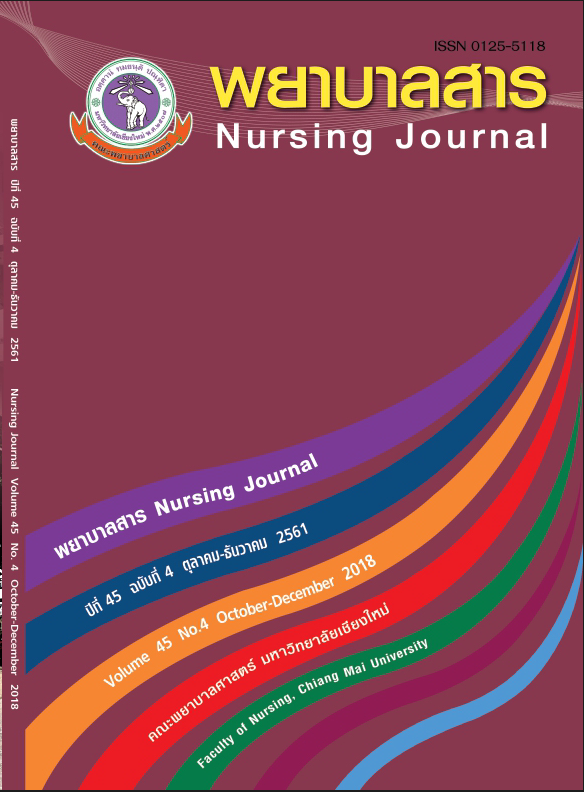Nursing car for Children with Electrolyte Imbalances
Keywords:
Caring for Children with Electrolyte Imbalances, Nurse’s RoleAbstract
Electrolyte imbalances are common in the hospitalized child. Hyponatremia and hypokalemia are most frequently electrolyte imbalances and are leading cause of morbidity and mortality from complications, especially neurological and cardiovascular complications. Caring for the hospitalized child with hyponatremia and hypokalemia, the nurse assumes the role of continuously monitoring for signs of complications and efficacy of treatments. The purpose of this article is to provide the knowledge and understanding for the nurse regarding hyponatremia and hypokalemia in children. The main issues are as follows: incidence, etiology, clinical manifestations, treatment, and nursing care, these can be used to plan appropriate care for children with hyponatremia or hypokalemia.
References
Bellomo, R., Martensson, J., & Eastwood, G. M. (2015). Metabolic and electrolyte disturbance after cardiac arrest: how to deal with it. Best Practice and Research Clinical Anaesthesiology, 29, 471-484.
Bibi, S., Bibi, S., Gilani, S. Y. H., Shah, S. R. A., Haq, A., & Billo, A.G. (2015). Frequency of hospital acquired hyponatremia in a pediatric tertiary care setting. Journal of Ayub Medical College Abbottabad, 27(3), 560-563.
Burns, R. A. & Kaplan, R. L. (2014). Renal and electrolyte emergencies. In K. N. Shaw, & R. G. Bachur (Eds.), Pediatric emergency medicine (7th ed.) (pp. 997-1021). Philadelphia: Wolters Kluwer.
Chaitra, K. M., Kumar, M., & Saipraneeth, R. G. (2016). Hyponatremia in lower respiratory tract infections. International Journal of Contemporary Pediatrics, 3(2), 381-384.
Chung, C. H., & Zimmerman, D. (2009). Hyponatremia and hypernatremia: Current understanding and management. Clinical Pediatric Emergency Medicine. 10(4), 272-278.
Corbett, A. H., Dana, W. J., Fuller, M. A., Gallagher, J. C., Golembiewski, J. A., & Gonzles, J. P., et al. (2014-2015). Drug information handbook (23th ed.). USA: Wolters Kluwer.
Daly, K., & Farrington, E. (2013). Hypokalemia and hyperkalemia in infants and children: Pathophysiology and treatment. Journal of Pediatric Health Care, 27(6), 486-496.
Dastidar, R. G. & Konar, N. (2017). A study of electrolyte disturbances in a child presenting with acute gastroenteritis, with special emphasis on hyponatremic dehydration: A hospital based cross-sectional study. Pediatrics & Therapeutics, 7(2), 1-4.
Dimke, H., Monnens, L., & Hoenderop, J. G. J. (2015). Evaluation of hypomagnesemia: Lessons from disorders of tubular transport. American Journal of Kidney Diseases, 62(2), 377-383.
Greenberg, J. H., Tufro, A., & Marsenic, O. (2015). Approach to the treatment of the infant with hyponatremia. American Journal of Kidney Diseases, 65(3), 513-517.
Hockenberry, M. J. & Wilson, D. (2009). Wong’s essentials of pediatric nursing (8th ed.). St. Louis: Mosby Elsevier.
Hockenberry, M., Wilson, D., & Rodgers, C. (2017). Wong’s essentials of pediatric nursing (10th ed.). St. Louis: Mosby Elsevier.
James, S. R., & Ashwill, J. (2007). Nursing care of children: Principles & practice (3rd ed.). St. Louis: Saunders Elsevier.
Jayakumar, B., & Sambasivam, E. (2017). Clinical profile, etiology, management and outcome of serum sodium disturbances in children admitted in PICU. International Journal of Research in Medical Science, 5(6). 2546-2551.
Katavetin, P., & Tiranathanagul, K. (2017). Disorders of water balance: Hyponatremia and
hypernatremia. In P. Khotchaseni, K. Kiattisunthorn, P. Kingwatanakul, V. Ophascharoensuk
(Eds.), Fluid, electrolyte and acid-base disorders (1st ed.) (pp. 27-43). Bangkok: Text and Journal
Publication Co Ltd. (In Thai).
Kwancharoen, R. (2017). SIADH and cerebral salt wasting. In C. Deerochanawong (Ed.), Endocrinology
in clinical practice (1st ed.) (pp. 81-103). Bangkok: Ruenkaew Printing. (In Thai).
Lander, A. (2016). Update guidelines management of fluid and electrolytes in children. Surgery, 34(5), 213-216.
Lumpaopong, A. (2017). Sodium disorders: Pediatric aspect. In P. Khotchaseni, K. Kiattisunthorn,
P. Kingwatanakul, V. Ophascharoensuk (Eds.), Fluid, electrolyte and acid-base disorders (1st
ed.) (pp. 319-327). Bangkok: Text and Journal Publication Co Ltd. (In Thai).
Liamis, G, Milionis, H. J., & Elisaf, M. (2011). Hyponatremia in patients with infectious disease. Journal of Infection, 63, 327-335.
Ndirangu, E. N. (2009) Prevalence of hyponatremia in children admitted at Kenyatta national hospital with pneumonia. (Unpublished master’s thesis). University of Nairobi, Kenya.
North of England Cancer Network. (2016). NECN guidelines for management of extravasation. Retrieved from http://www.necn.nhs.uk/wp-content/uploads/2012/11/NECN-Guidelines-for-Management-of-Extravasation-v5.5-Nov-2016.pdf
Omer, R., Masood, M. K., Ashar, S., Jawad, M., Afzal, A., & Khan, H. I. (2017). Dysnatremias; Dysnatremias in pediatric critical care, etiology, epidemiology and effect on outcomes. Professional Medical Journal, 24(7), 1976-1080.
Pattaragarn, A. (2016). Dysnatremia. In Sumboonnanonda, A., Pattaragarn, A., Piyaphanee, N. (Eds.), Fluid and electrolyte in children: Common disorders (1st ed.) (pp. 35-57). Bangkok: Methikul Printing. (In Thai).
Pruangprasert, P., & Sumboonnanonda, A. (2016). Dyskalemia. In A. Sumboonnanonda, A. Pattaragarn, N. Piyaphanee (Eds.), Fluid and electrolyte in children: Common disorders (1st ed.) (pp. 59-79). Bangkok: Methikul Printing. (In Thai).
Price, J. F., Kantor, P. F., Shaddy, R. E., Rossano, J. W., Goldberg, J. F., Hagan, J., et al. (2016). Incidence, severity, and association with adverse outcome of hyponatremia in children hospitalized with heart failure. The American Journal of Cardiology, 118(7), 1006-1010.
Rafat, C., Flamant, M., Gaudry, S., Vidal-Petiot, E., Ricard, J. D., & Dreyfuss, D. (2015). Hyponatremia in the intensive care unit: How to avoid a Zugzwang situation. Annals of Intensive Care, 5(39), 2-27.
Sachdev, A., Pandharikar, N., Gupta, D., Gupta, N., Gupta, S., & Venkatramanet, S. T. (2017). Hospital-acquired hyponatremia in pediatric intensive care unit. Indian Journal of Critical Care Medicine, 21(9), 61-65.
Somers, J. M., & Traums, Z. (2016). Hyponatremia in children. Retrieved from https://www.uptodate.com/contents/hypokalemia-in-children
Spasovski, G., Vanholder, R., Allolio,B., Annane, D., Ball, S., Bichet, D., et al. (2014). Clinical practice guideline on diagnosis and treatment of hyponatraemia. European Journal of Endocrinology, 170(3), G1-G47.
Vasudevan, A., & Phadke, K. (2014). Fluid, electrolytes, and acid-base disorders. In K. Phadke, P. Goodyer, M. Bitzan (Eds.), Manual of pediatric nephrology (pp. 65-139). London: Springer.
Viera, A. J. & Wouk, N. (2015). Potassium Disorders: Hypokalemia and Hyperkalemia. American Family Physician Journal, 92(6), 487-495.
Zieg, J. (2017). Pathophysiology of hyponatremia in children. Frontiers in Pedaitrics, 5(213).
Downloads
Published
How to Cite
Issue
Section
License
บทความที่ได้รับการตีพิมพ์เป็นลิขสิทธิ์ของวารสารพยาบาลสาร
ข้อความที่ปรากฏในบทความแต่ละเรื่องในวารสารวิชาการเล่มนี้เป็นความคิดเห็นส่วนตัวของผู้เขียนแต่ละท่านไม่เกี่ยวข้องกับมหาวิทยาลัยเชียงใหม่ และคณาจารย์ท่านอื่นๆในมหาวิทยาลัยฯ แต่อย่างใด ความรับผิดชอบองค์ประกอบทั้งหมดของบทความแต่ละเรื่องเป็นของผู้เขียนแต่ละท่าน หากมีความผิดพลาดใด ๆ ผู้เขียนแต่ละท่านจะรับผิดชอบบทความของตนเองแต่ผู้เดียว






